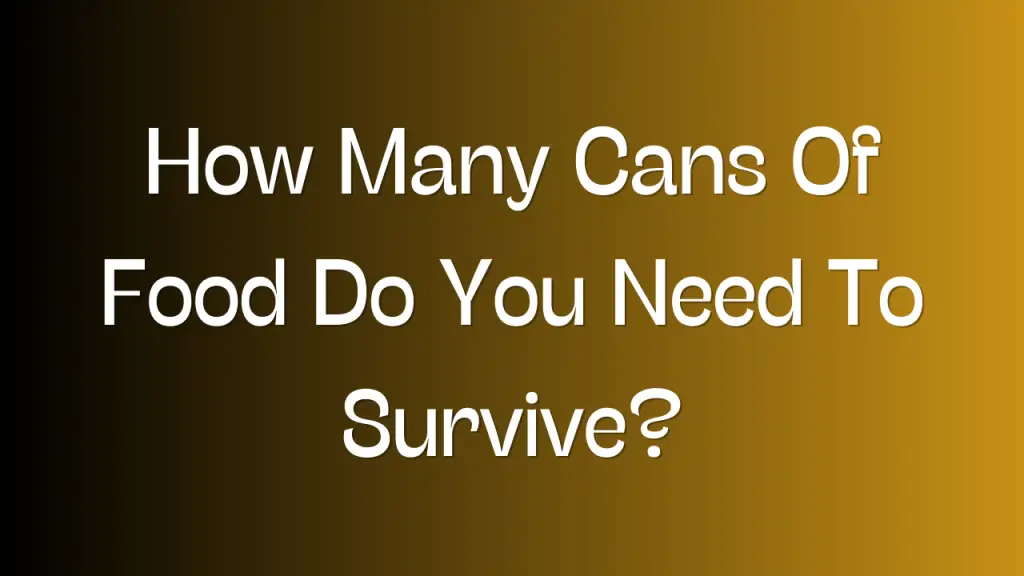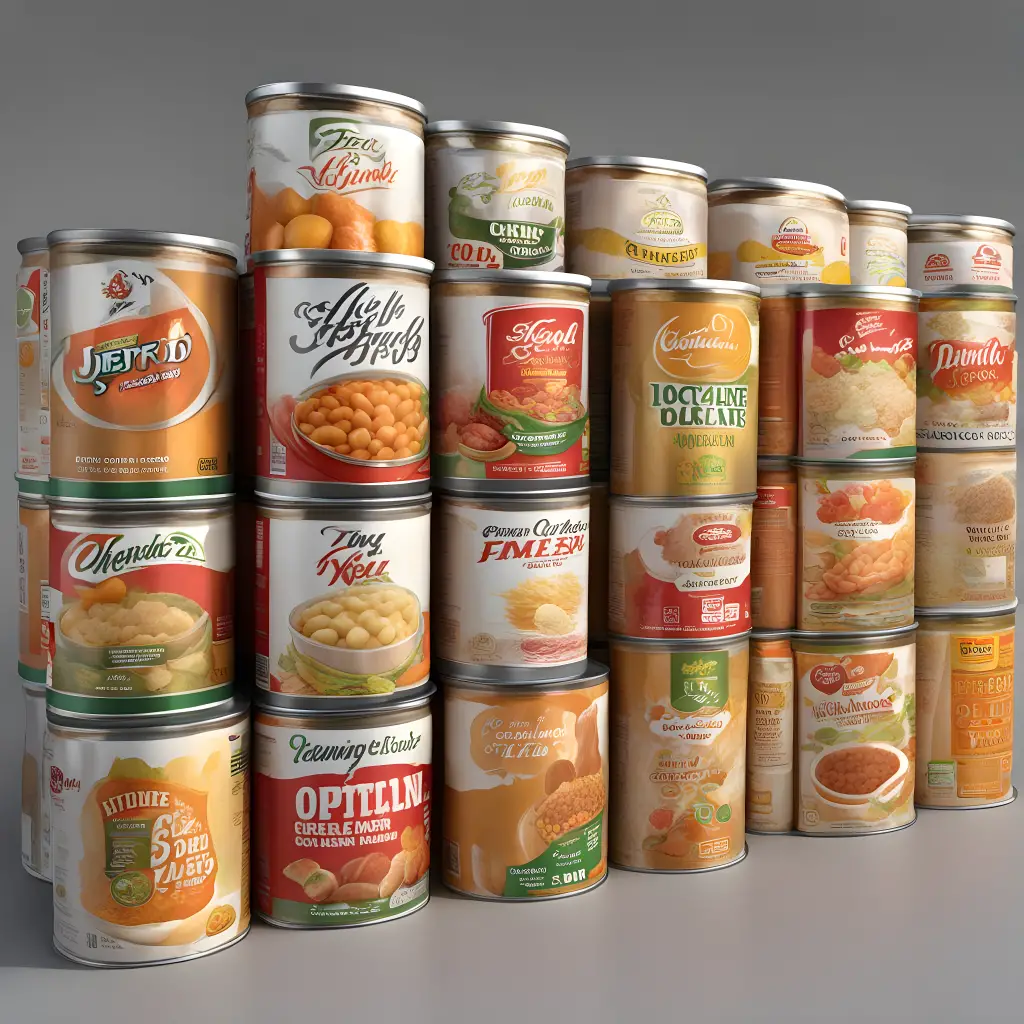
Are you prepared for a situation where your access to fresh food is limited? Whether it’s a natural disaster or a global crisis, it’s important to have a plan in place to ensure your survival. One important aspect of that plan is determining how many cans of food do you need to survive.
In this article, we will guide you through the process of calculating your individual needs, assessing the duration of the situation, and creating a stockpile plan that will help you stay nourished and healthy during these challenging times.
When it comes to surviving on canned food, it’s crucial to consider your individual needs. Factors such as age, gender, and activity level all play a role in determining how many calories you require on a daily basis. By calculating your caloric requirements, you can get a better understanding of how much food you should stockpile.
Additionally, you need to assess the duration of the situation you are preparing for. Is it a short-term emergency or a long-term crisis? This will determine the quantity of cans you need to store.
How Many Cans Of Food Do You Need To Survive?
Survival food requirements vary, but a general guideline is to have at least three days’ worth of canned food per person in an emergency. This typically equates to about 9–12 cans per person, focusing on non-perishable items like canned beans, vegetables, and soups.

By taking these factors into account, you can make an informed decision about the number of cans of food you need to survive and thrive in any challenging situation.
Consider Your Individual Needs
Think about what you specifically need to survive and how many cans of food you’ll require to meet those needs.
There are several factors to consider when determining the amount of cans of food you need. Firstly, your personal dietary restrictions play a significant role in determining the quantity of cans you should have. If you have any allergies or intolerances, you need to ensure that the cans of food you choose don’t contain any ingredients that could potentially harm you.
Additionally, if you follow a specific diet, such as vegetarian or vegan, you would need to select foods that align with your dietary preferences.
Furthermore, you should consider your individual needs when determining the number of cans of food needed for survival. Factors such as your age, weight, and activity level all impact the amount of food you require. For example, a young adult who’s physically active may need more calories and nutrients compared to an older individual with a sedentary lifestyle.
It’s important to assess your specific needs and consult with a healthcare professional or nutritionist to determine the appropriate quantity of canned food required for your survival. By taking into account these factors and personal dietary restrictions, you can ensure that you have enough cans of food to sustain yourself in case of an emergency situation.
Calculate Your Caloric Requirements
To ensure your survival, it’s crucial to calculate the number of calories your body requires. Healthy eating and meal planning are essential factors in determining the number of cans of food you need to sustain yourself. By calculating your caloric requirements, you can ensure that you are consuming enough food to meet your body’s energy needs.
To calculate your caloric requirements, you need to consider factors such as your age, gender, weight, height, and activity level. A simple way to estimate your daily caloric needs is by using a basal metabolic rate (BMR) calculator. The BMR is the number of calories your body needs to maintain basic functions at rest. Once you have determined your BMR, you can then factor in your activity level to get a more accurate estimate of your daily caloric needs.
To make it easier for you to understand how many cans of food you need, here’s a table to give you a general idea based on an average 2000-calorie diet:
| Food Item | Calories per Can |
|---|---|
| Canned Tuna | 120 |
| Canned Beans | 220 |
| Canned Soup | 300 |
Keep in mind that this is just a rough estimate, and individual needs may vary. It’s important to consult with a healthcare professional or a registered dietitian to determine the specific number of cans of food you need based on your unique circumstances. By calculating your caloric requirements and incorporating healthy eating and meal planning into your survival strategy, you can ensure that you have enough cans of food to sustain yourself during challenging times.
Assess the Duration of the Situation
Assessing the duration of the situation is crucial in order to develop an effective plan for sustaining yourself during challenging times. By evaluating the length of time you expect to be in a survival situation, you can determine the amount of food you’ll need to stockpile.
This assessment involves considering factors such as the availability of food sources and the likelihood of replenishment. To assess food availability, you should take into account the resources that are accessible to you. Are there any nearby grocery stores or markets that might still have supplies during the crisis? Can you rely on hunting, fishing, or foraging for food? By understanding the options at your disposal, you can estimate the quantity of food you can reasonably obtain.
Estimating ration sizes is another crucial aspect of assessing the duration of the situation. How many calories do you need to consume each day to maintain your energy levels? This will depend on factors such as your age, gender, and activity level. Once you’ve determined your daily caloric requirements, you can calculate the number of cans of food you’ll need to consume each day to meet those needs.
Assessing the duration of the situation is key to developing a comprehensive plan for sustaining yourself during challenging times. By evaluating food availability and estimating ration sizes, you can ensure that you have an adequate supply of food to survive. Remember to consider all possible food sources and your individual caloric requirements when making these assessments.
Determine Serving Sizes and Nutritional Content
Knowing the nutritional content and appropriate serving sizes of the food you’ve stockpiled is essential for maintaining your energy levels and overall health during challenging times. In order to make the most of your limited resources, it’s important to practice portion control and adhere to dietary guidelines.
By understanding the serving sizes recommended for different food groups, you can ensure that you’re consuming the right amount of nutrients to sustain yourself.
Portion control is crucial because it helps you ration your food supply effectively. It allows you to stretch your stockpile and make it last longer. Additionally, following dietary guidelines ensures that you’re getting a balanced intake of essential nutrients. These guidelines are specifically designed to meet your body’s needs and maintain your health.
By adhering to them, you can ensure that your body receives the necessary vitamins, minerals, and macronutrients for optimal functioning.
Being aware of the serving sizes and nutritional content of the food you’ve stockpiled is vital for your survival. Practicing portion control and following dietary guidelines will help you make the most of your resources and maintain your health during challenging times. Remember, it’s not just about staying alive; it’s also about staying healthy and energized to overcome any obstacles that come your way.
Create a Stockpile Plan
Creating a stockpile plan involves carefully strategizing and organizing your available resources to ensure you have a well-rounded and sustainable supply during challenging times. This is crucial for long-term storage and meal planning.
Here are some steps to help you create an effective stockpile plan:
- Assess your needs: Determine how many people you need to provide for and how long you want your stockpile to last. Consider any dietary restrictions or special needs.
- Calculate quantities: Calculate the amount of food you’ll need based on the number of meals per day and the number of days you want your stockpile to last. Consider the nutritional value and variety of the food items.
- Rotate your stock: To ensure freshness and avoid waste, create a system for rotating your stockpile. Use the oldest items first, and replenish your supplies regularly.
- Store properly: Choose a cool, dry, and dark location for your stockpile. Use airtight containers or cans to protect the food from pests, moisture, and oxygen.
By following these steps, you can create a stockpile plan that will provide you with peace of mind and a sense of security during uncertain times. It allows you to have a long-term storage solution and ensures you have enough food to sustain yourself and your loved ones while also considering meal planning and nutritional needs.
Conclusion
In conclusion, how many cans of food do you need to survive? You need to consider your individual needs when determining how many cans of food you need to survive. Everyone has different dietary requirements, so it’s important to take that into account when creating your stockpile plan.
Additionally, calculating your caloric requirements will help you determine how many cans of food you should have on hand.
Furthermore, assessing the duration of the situation is crucial in determining the quantity of cans you need. If you’re preparing for a short-term emergency, you may not need as many cans as you would for a long-term survival situation.
Lastly, determining serving sizes and nutritional content is essential for ensuring you have a balanced and nourishing supply of food.
By considering these factors and creating a well-thought-out stockpile plan, you can ensure that you have enough cans of food to sustain yourself during any emergency or crisis.
Remember to regularly check and rotate your stockpile to ensure freshness and replace any expired or damaged cans. With proper planning and preparation, you can have peace of mind knowing that you have enough food to survive.
